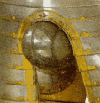 A Briefe History of the Codpiece
A Briefe History of the Codpiece
Part the First
by Lord Samuel Piper
The codpiece has held a certain fascination, as well as other important items, for those of us in the Society for Creative Anachronism. It has been regarded with fear and ignorance by many men and a certain reverence by some women. This timely bit of scholarly research should help dispel the fear and ignorance. Any ladies having problems with the “reverence” bit will need to speak with me personally.
In Middle English, “Cod” (or “Codd” in Old English, “Coddd” in Exceedingly Old English) meant “bag” or “scrotum”, which led to some interesting moments when dining out at the Renaissance equivalent of Long John Silver’s. “This is the tastiest codd I’ve ever had in my mouth” was a guaranteed show stopper, bringing about numerous jokes and a homicide or two.
The simple flap was buttoned closed, laced closed, tied closed, or occasionally glued closed after a particularly exciting night at “The Yellowe Rose Publick Howse.”
The codpiece remained flat cloth for a number of years. While visiting England, Duke Fabrizio of Bologna, dressing hastily after a quick romantic interlude, used the flap to contain (or perhaps restrain) his nether parts while appearing before King Henry VIII and Queen Anne Boleyn.
| Queen Anne, amused at the Italian’s conspicuous bulge, remarked “Be that thine codling or art thou glad to see me?” Of course, “codling” is 15th century English for either a “small, immature apple” or “any of several elongated greenish English cooking apples,” so we may never know if the Duke’s fruit was being ridiculed or complimented. |
 |
 |
 |
 |
“bologna” codpiece
|
“huevos rancheros” codpiece |
“foofy” codpiece
|
“sausage o’ steel” codpiece |
 |
Coming in Part the Second : More word origins – What happened when the codpiece of King Richard III (Dick to his friends) came unbuttoned. |



